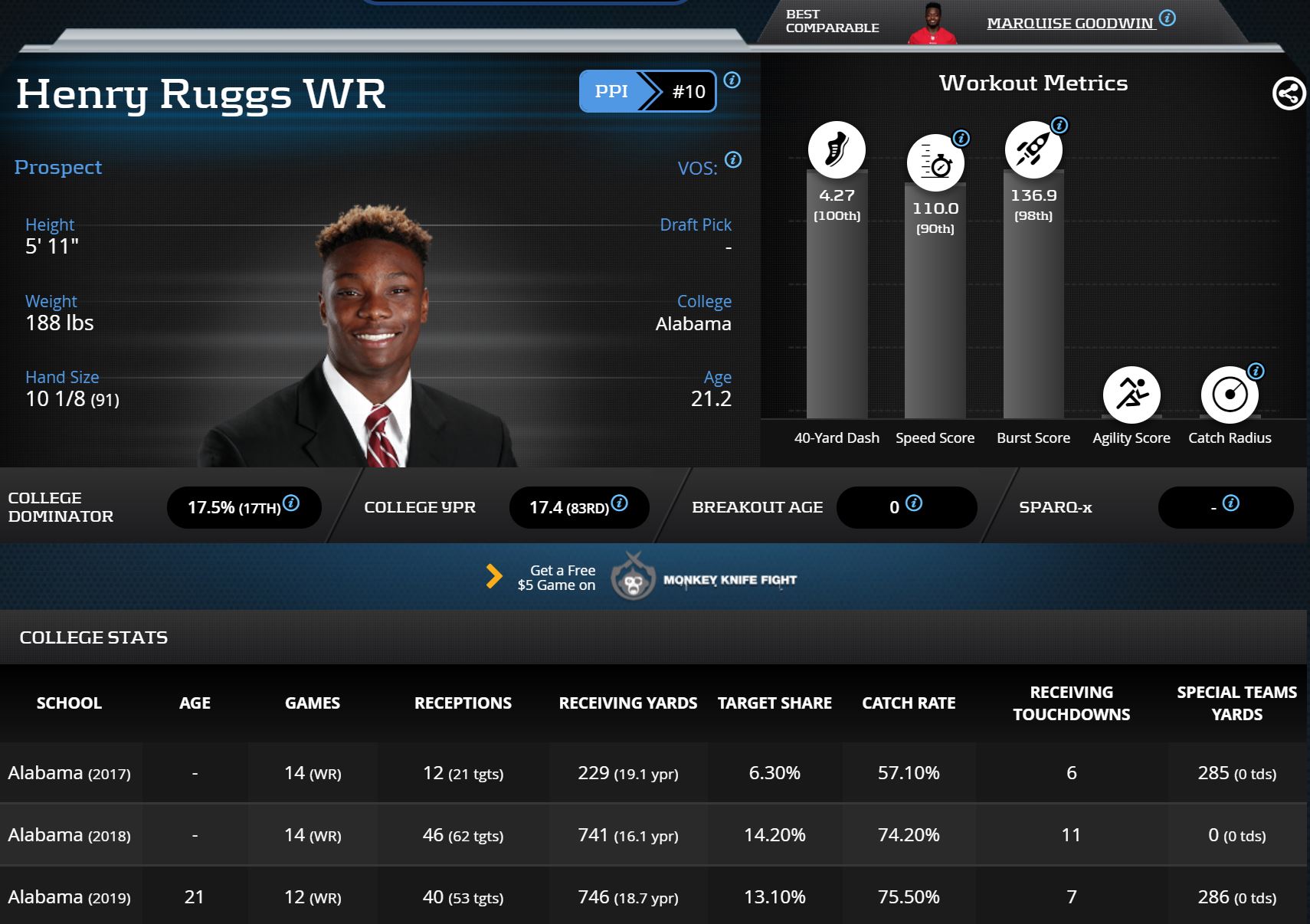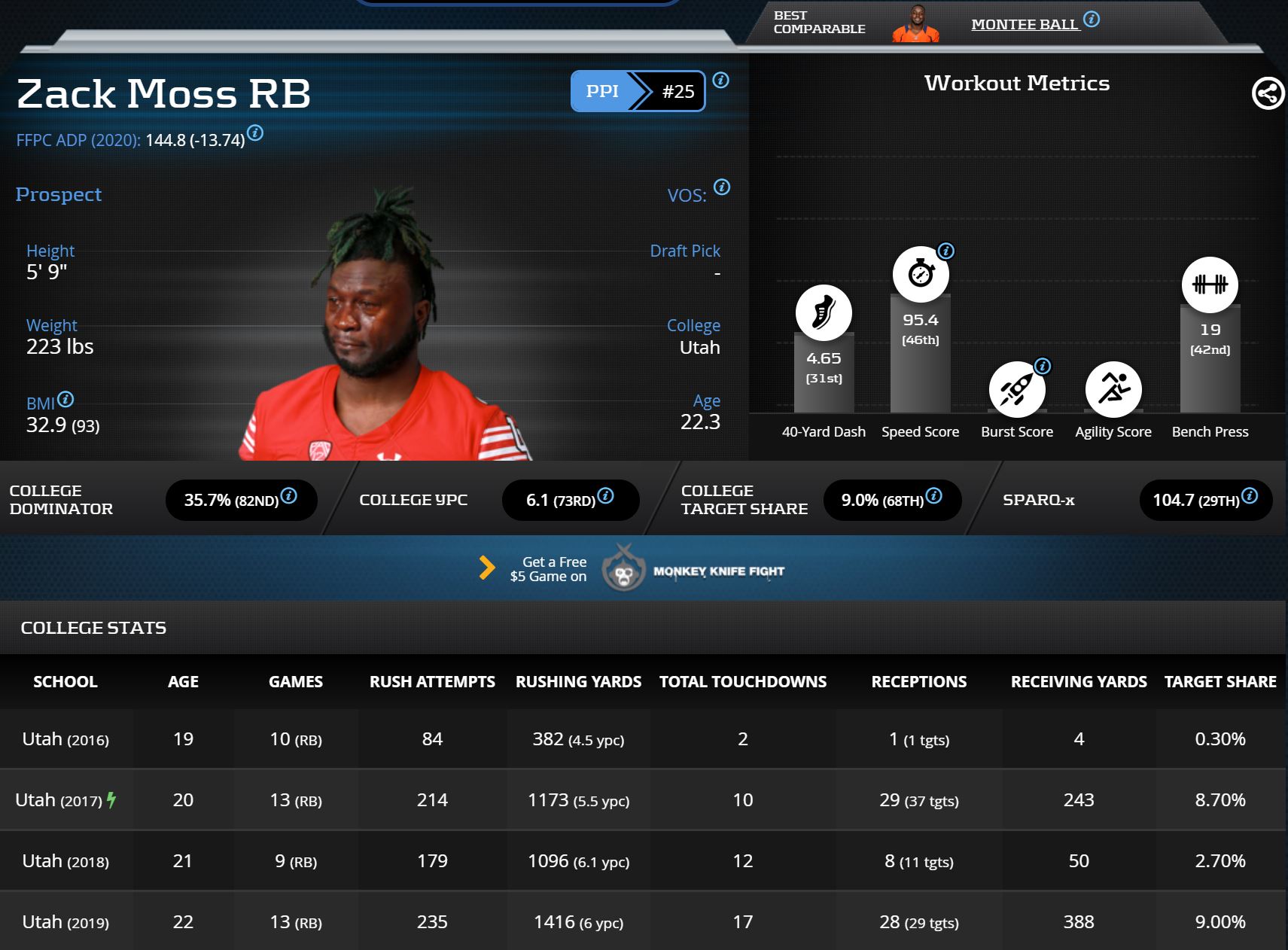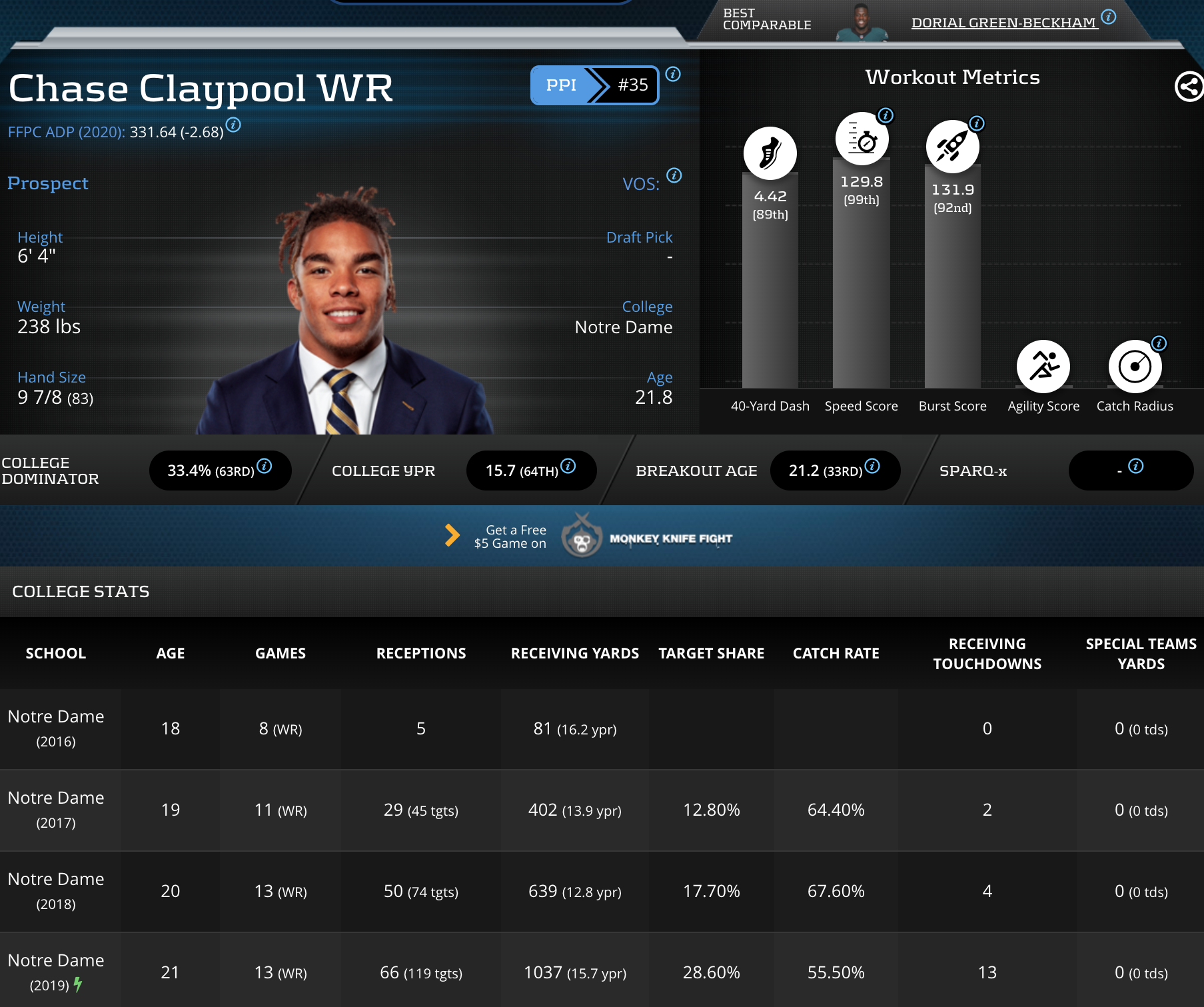With the NFL Draft and subsequent rookie drafts approaching, it’s easy to get caught in the hype of incoming prospects. Reading Combine numbers without additional context can lead to the regret that John Ross, Kevin White, and Corey Coleman owners would eventually feel. We’re going to help sift through the smoke and mirrors that draft season and rookie fever causes. Using advanced stats and metrics, these are three prospects that dynasty leaguers need to avoid drafting in the coming weeks.
Henry Ruggs, WR, Alabama
After blazing the Combine with a 4.27 (100th-percentile among qualified wide receivers) 40-yard dash, Henry Ruggs became the draft’s most polarizing prospect. He oozes with Tyreek Hill-level upside, but is the riskiest prospect in recent memory. Ruggs never posted a College Dominator Rating over 20-percent, earning him a nonexistent Breakout Age on his player page. In his defense, he competed with Jerry Jeudy, Devonta Smith, and Jaylen Waddle on a stacked Alabama team. All three of those receivers will likely be first or second round draft picks. Jeudy and Ruggs have the highest Teammate Scores in the class at 98.7. Even when taking Ruggs’ competition into account, these numbers cannot simply be discarded. In the NFL, every team has as much talent as the Alabama receiving corps. If anything, Ruggs’ underwhelming production in an NFL-level receiving room is the perfect window into his production as a pro.
Ruggs’ most concerning advanced metric might actually be his Dynamic Score. According to the Breakout Finder App, he posted a 20.3 (No. 18) Dynamic Score, which puts him in the middle of the pack among receivers. He returned kicks his freshman and senior season, averaging 21 yards per return. He only earned two career rushing attempts, though he broke one for a 75-yard touchdown against New Mexico State. Ruggs is said to be a “game-breaker,” yet Alabama coaches never went out of their way to get him the football. It’s plausible that he may be more Marquise Goodwin than Tyreek Hill, best used as a decoy in the deep areas of the field.
https://www.youtube.com/watch?v=Wr7TdUQjfPk
Based on speed alone, Ruggs has the potential to be a weapon for an NFL offense in the years to come. With that said, he should be viewed as more of an NFL talent than a dynasty asset. He projects to be a field stretcher with low volume and unpredictable week to week production. Going at the 1.10 (WR5) in rookie drafts, he’s a must fade at his current ADP with alternatives such as Denzel Mims, Jalen Reagor, and Justin Jefferson all going around this same spot.
Zack Moss, RB, Utah
Zack Moss had the most lackluster combine in recent memory. At 5-9, 223-pounds, he ran a 4.65 (31st-percentile) 40-yard dash, earning him a 95.4 (46th-percentile) Speed Score. In 2019, only four of the Top 24 qualified running backs in Fantasy Points Per Game ran slower than a 4.60 coming out of school. In the face of sub-athleticism, film grinders will continue to tout Moss’ tackle-breaking and on-film elusiveness. Unable to learn from past mistakes, they will fall in love with the David Montgomery of the 2020 Draft Class.
After the Combine, fantasy gamers were quick to run to best-case scenario and point out Moss’ 9.0-percent (68th-percentile) College Target Share. While it’s impressive for a bigger back, it’s also concerning upon deeper inspection. After catching 29 passes in his sophomore year, he only had eight receptions the following season in nine games played. During his senior year, he posted that 9.0-percent share despite only catching two passes for seven yards in his first five games. The bulk of his receiving production took place over his last eight games. Knowing that the NFL values pass-catching running backs, it’s clear that the Utah coaching staff forced targets to Moss down the stretch to boost his draft stock. With context in mind, his senior year receiving numbers are inconsistent and create a cause for concern.
https://www.youtube.com/watch?v=d4Hw4AQN2Z0
Moss has been praised as the next Kareem Hunt or Le’Veon Bell. Both of these players are extreme outliers. At the next level, it is rare for backs with their sub-athlete profiles to become bell cows in dynasty. With probability in mind, it is foolish to project Moss at his absolute ceiling. PlayerProfiler’s more realistic comparisons include the likes of Montee Ball, David Montgomery, and Benny Snell. None of these players fit the profile of a top-24 back in dynasty. Moss is currently going at the 2.02 in rookie drafts and should move up in ADP if Day 2 draft capital is spent on him. He’s an easy fade given the high-upside options available in the late-first.
Chase Claypool, WR, Notre Dame
Chase Claypool won’t be a late-round pick in rookie drafts for long. In recent NFL mock drafts, Claypool is a consensus Day 2 draft pick and is going as high as pick No. 44 to the Indianapolis Colts. It’s not a matter of if his ADP will skyrocket, its a matter of when.
Claypool put on a show at the Combine, recording a 129.8 (99th-percentile) Speed Score and 131.9 (92nd-percentile) Burst Score at 6-4, 238-pounds. Don’t buy into the hype. His size and speed can be drool-worthy, but it’s likely a trap given his production profile. While at Notre Dame, he broke out at age 21.2 (33rd-percentile) and posted a 33.4-percent (63rd-percentile) College Dominator Rating. In addition to a late breakout, Claypool lacks dynamism. He posted a 0.6 (No. 36) Dynamic Score at the college level. He had three career rushing attempts for six yards, proving to be ineffective in space as a playmaker.
Check out Chase Claypool on PlayerProfiler’s Updated Rookie Rankings:
Claypool’s greatest downfall may actually be his face-melting Combine. At his size, many teams requested he workout as a tight end at the Senior Bowl, but he declined. After smashing the Combine, there’s now a much lower chance he converts to tight end. With Day 2 rumors flying around the league, Claypool will be advertised in dynasty as the next D.K. Metcalf. His most likely career arc is similar to Darren Waller‘s (hopefully without the numerous suspensions). He will struggle as a receiver and switch to tight end by the end of his rookie contract. With an eventual transition to tight end, he becomes a “project” dynasty asset that will collect dust on taxi squads. If his ADP shoots up into the second round of rookie drafts, he’s an easy fade at that price tag.






